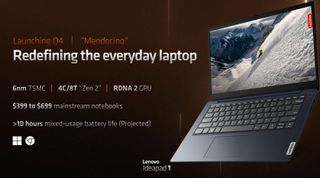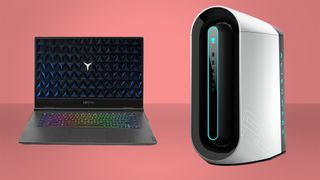The Steam Deck APU gets a 6nm refresh to power AMD's best-in-class budget laptops
With Zen 2 CPU and RDNA 2 GPU cores, the new AMD Mendocino APU sure looks a lot like the Aerith chip from Valve's handheld.

AMD's wheeling out what looks like a modified version of the Steam Deck's Aerith APU to power a new range of budget gaming laptops it's codenamed AMD Mendocino. The Mendocino program, introduced during AMD's Computex keynote, is designed to create a new class of notebooks in the $399 - $599 category with unprecedented power and battery life.
Okay, it's not the exact Steam Deck APU, but it sure bears more than a passing resemblance to it. This is a quad-core, eight-thread Zen 2-based APU, that still sports RDNA 2 GPU cores, and also supports LPDDR5.
So yeah, pretty similar. The only difference I can see for right now is that its manufactured on a TSMC 6nm node, as opposed to the 7nm node Valve's handheld operates with. AMD hasn't said anything about the compute unit count, but hopefully it won't be any lower than the eight CUs of the Deck's Aerith.
Being similar to the Steam Deck's APU is definitely no bad thing for a notebook, because with the larger footprint you can offer more cooling, more power, and space for higher capacity batteries. That would potentially allow AMD, and whoever it partners with in the Mendocino program, to up the clock speeds of the chip, on both CPU and GPU sides, and eat up more than the 15W TDP of the Steam Deck's processor.
And offering more than a 40Whr battery would make a big difference in terms of up time. That's something AMD sees as a must for a Mendocino laptop.
"Combining Zen2 cores with the best and the brightest of the Ryzen 6000 series," says Robert Hallock, AMD marketing director for Ryzen CPUs at our Computex briefing, "you get Ryzen 6000 series graphics with RDNA2, you get Ryzen 6000 series battery life, you get Ryzen 6000 series video encode and decode, and you get a huge bump in the average battery life in this class.
"Most people are used to 4, 5 ,6 hours… with Mendocino we want at a minimum, 10 hours out of these notebooks."
The biggest gaming news, reviews and hardware deals
Keep up to date with the most important stories and the best deals, as picked by the PC Gamer team.


Best gaming PC: The top pre-built machines from the pros
Best gaming laptop: Perfect notebooks for mobile gaming
Given the ludicrous price increases in modern PC technology, having AMD coming to the table offering something for mainstream users is a definite win. The Steam Deck is similarly well-priced for a piece of current hardware, and these Mendocino laptops could deliver some welcome 720p gaming performance in the sub-$699 notebook weightclass.
"We really want to change the experience for people in the entry level and mainstream with this Mendocino program," enthuses Hallock, "bringing many of the same premium technologies of the Ryzen 6000 series down to a more accessible price point.
"And we absolutely want to lead in performance and battery life in this category."
Support for the Mendocino APU was added to CPU-Z back in April, but AMD is so far only giving a broad second half of 2022 timeframe for release. Though our press slide deck, and the Computex presentation both say Q4. But hey, they could make for a neat Christmas present, right?

Dave has been gaming since the days of Zaxxon and Lady Bug on the Colecovision, and code books for the Commodore Vic 20 (Death Race 2000!). He built his first gaming PC at the tender age of 16, and finally finished bug-fixing the Cyrix-based system around a year later. When he dropped it out of the window. He first started writing for Official PlayStation Magazine and Xbox World many decades ago, then moved onto PC Format full-time, then PC Gamer, TechRadar, and T3 among others. Now he's back, writing about the nightmarish graphics card market, CPUs with more cores than sense, gaming laptops hotter than the sun, and SSDs more capacious than a Cybertruck.
Most Popular






